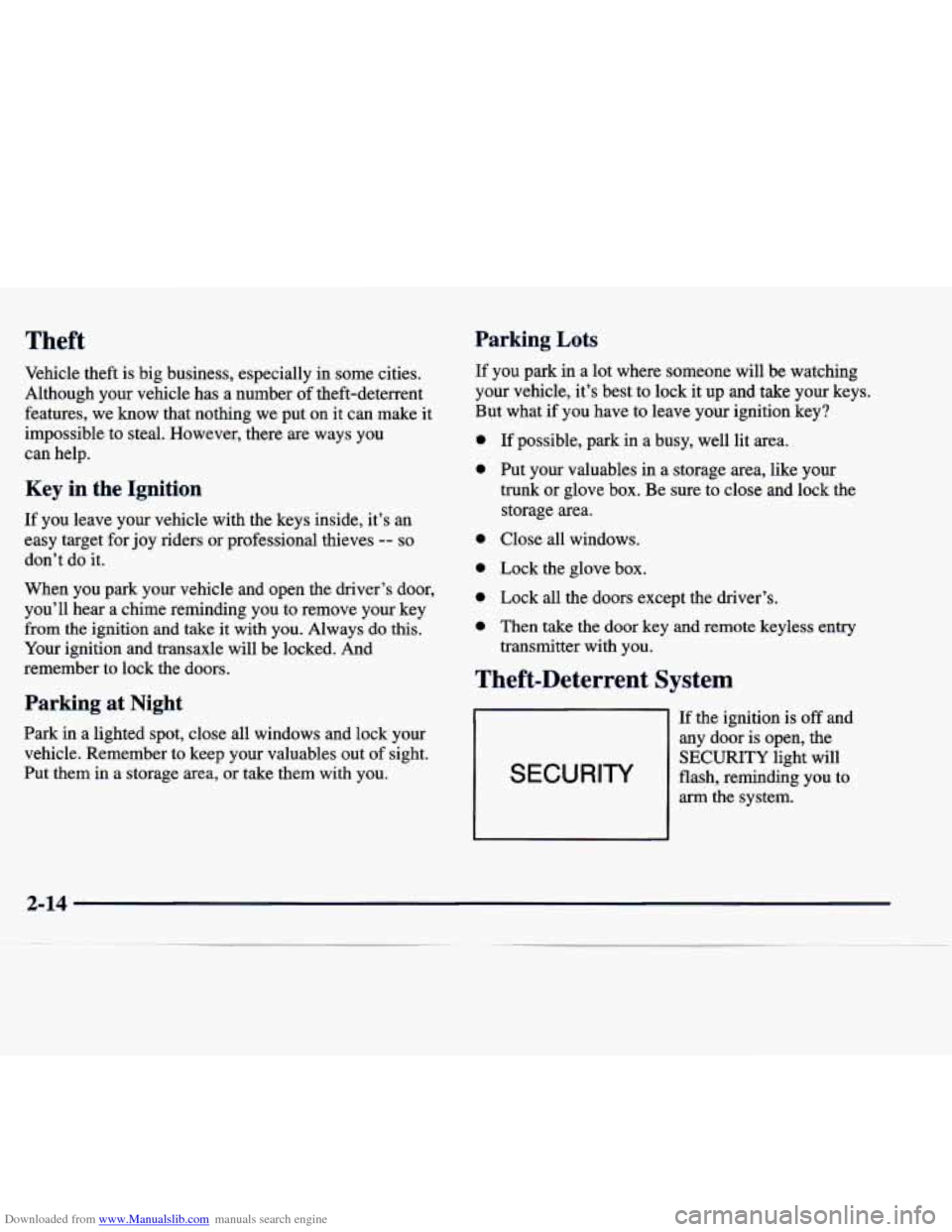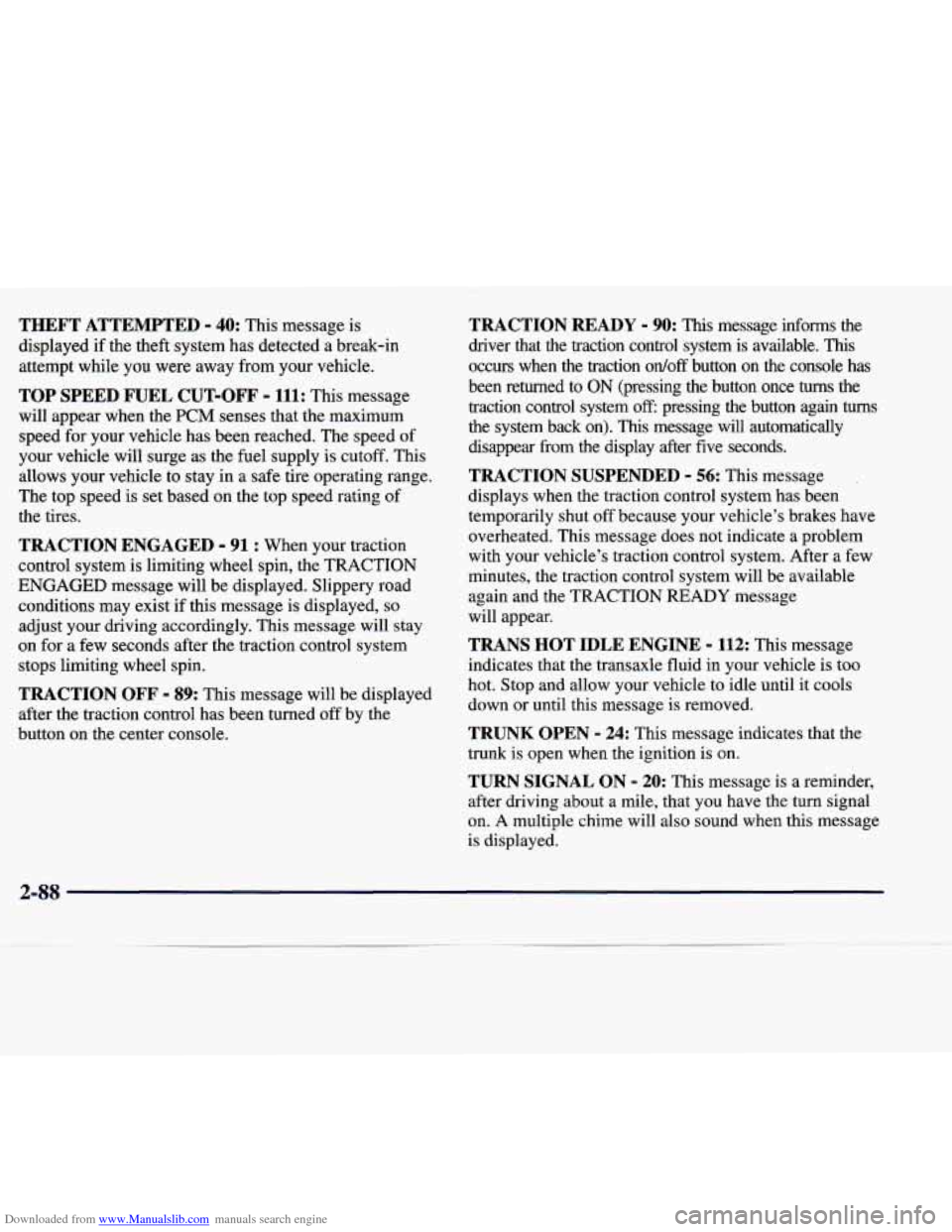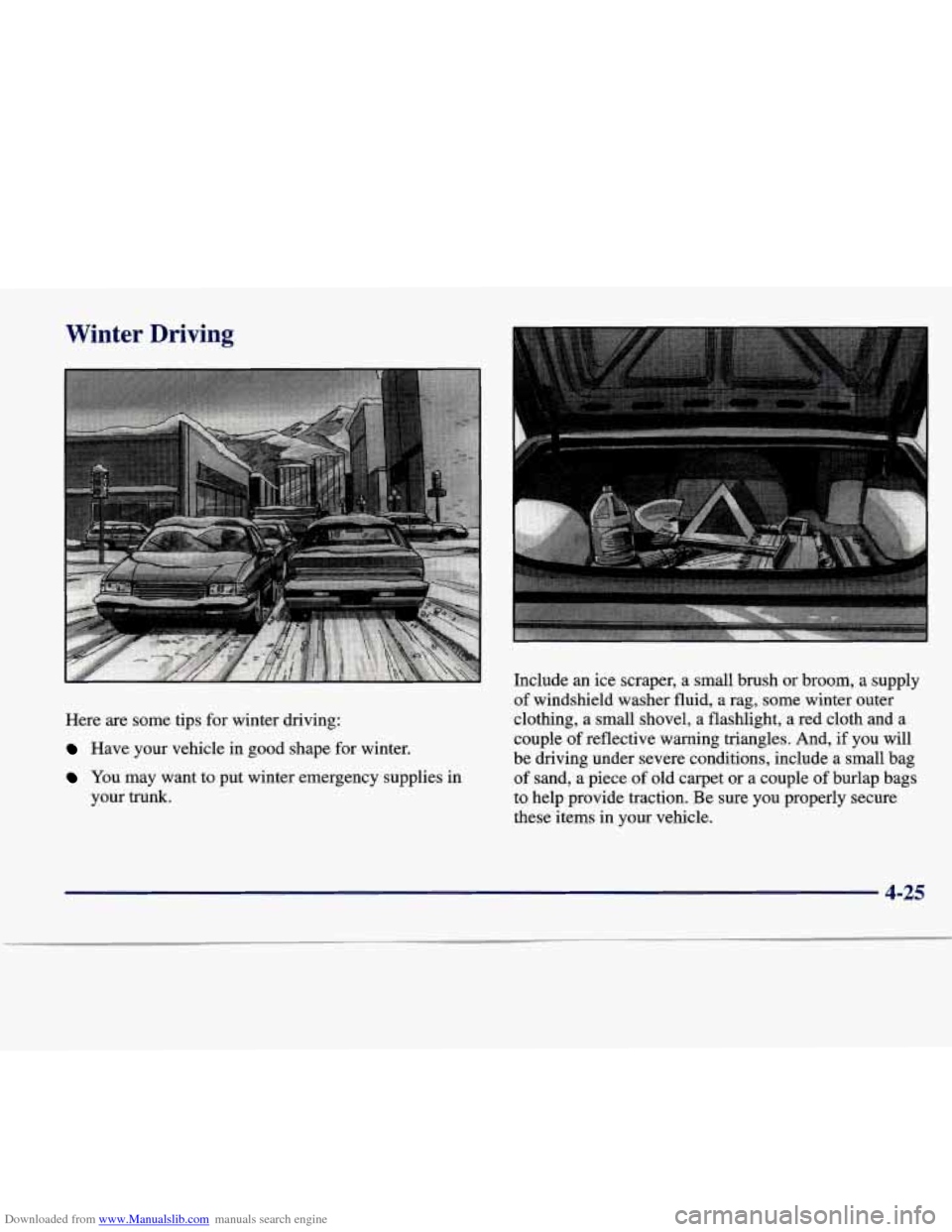1998 CADILLAC SEVILLE trunk
[x] Cancel search: trunkPage 75 of 378

Downloaded from www.Manualslib.com manuals search engine Theft Parking Lots
If you park in a lot where someone will be watching
your vehicle, it’s best to lock it up and take your keys.
But what
if you have to leave your ignition key?
Vehicle theft is big business, especially in some cities.
Although your vehicle has a number of theft-deterrent
features, we know that nothing we put on it can make it
impossible to steal. However, there
are ways you
can help.
Key in the Ignition
If you leave your vehicle with the keys inside, it’s an
easy target for joy riders or professional thieves -- so
don’t do it.
When you park your vehicle and open the driver’s door,
you’ll hear a chime reminding you to remove your key from the ignition and take
it with you. Always do this.
Your ignition and transaxle will be locked. And
remember to lock the doors.
Parking at Night
Park in a lighted spot, close all windows and lock your
vehicle. Remember to keep your valuables out of sight.
Put them in a storage area, or take them with you.
0
0
0
0
0
0
If possible, park in a busy, well lit area.
Put your valuables in
a storage area, like your
trunk or glove
box. Be sure to close and lock the
storage area.
Close all windows.
Lock the glove box.
Lock all the doors except the driver’s.
Then take the door key and remote keyless entry
transmitter with you.
SECURITY
If the ignition is off and
any door is open, the
SECURITY light will
flash, reminding you to
arm the system.
2-14
Page 76 of 378

Downloaded from www.Manualslib.com manuals search engine To arm the system, do the following:
1. Open the door.
2. Lock the door using the power door lock switch or
the RKE system with the door open. The
SECURITY light should come on and stay on.
off within approximately
30 seconds.
3. Close all the doors. The SECURITY light should go
When the theft system activates, the horn will sound and
the lamps will flash for about
30 seconds when the door
or trunk is opened without the key or RISE system.
Remember, the theft-deterrent system won’t arm if you
lock the doors with a key or use the manual door lock. It
activates only if you use a power door lock switch with
the door open or the
RKE system.
To avoid activating the alarm by accident:
The vehicle should be locked with the door key or
the manual door lock switch
after the doors are
closed
if you don’t want to arm the theft-deterrent
system.
0 Always unlock a door with a key or use the RKE
system. (Pressing the unlock button on the RKE
transmitter disables the theft-deterrent system.)
Unlocking a door any other way will activate the
alarm when a door or the trunk is opened. If you
activate the alarm by accident, unlock the driver’s
door with your key. You can also turn off the alarm by
using the unlock button
of the RKE system, or by
starting the car with
a valid key.
Changes or modifications made to this system by other than an authorized service facility could void
authorization to use the theft system.
Testing the Alarm
1. From inside the vehicle, roll down the window, then
get out of the vehicle, keeping the door open.
2. From outside of the vehicle, with the door open, lock
the vehicle using the power door lock or the RKE
system and close the door. Wait
30 seconds until the
SECURITY lamp goes
off.
3. Reach in and unlock the door using the manual lock
and open the door. The horn will sound and the
hazard lights will flash.
If the alarm does not sound when it should, check to see
if the horn works. The horn fuse may be blown. To
replace the fuse, see “Fuses and Circuit Breakers” in the
Index. If the fuse does not need to be replaced, you may
need to have your vehicle serviced.
To reduce the possibility of theft, always
arm the optional
theft-deterrent system when leaving your vehicle.
Page 77 of 378

Downloaded from www.Manualslib.com manuals search engine Valet Lock
the glovebox on the left-hand side. Pressing this switch to
ON will disable the use of
the trunk, fuel door and
garage door opener.
Pressing this switch to OFF will make these features
reusable. Locking the glove
box with your key will also
help to secure your vehicle. Note that the RKE
transmitter can't open the
trunk or fuel door if the valet
lock switch is on.
PASS-Key' 111
Your vehicle is equipped with the PASS-Key I11
(Personalized Automotive Security System)
theft-deterrent system. PASS-Key
111 is a passive
theft-deterrent system. This means you don't have to do
anything different to arm or disarm the system. It works
when you insert
or remove the key from the ignition. Your PASS-Key
I11 system operates on a radio
frequency subject
to Federal Communications
Commission (FCC) Rules and with Industry Canada.
This device complies with Part 15 of the FCC Rules.
Operation is subject to the following two conditions:
(1) this device may not cause harmful interference,
and
(2) this device must accept any interference received,
including interference that may cause undesired operation.
This device complies with RSS-210 of Industry Canada.
Operation is subject to
the following two conditions:
(1) this device may not cause interference, and (2) this device
must accept any interference received, including interference
that may cause undesired operation
of the device.
Changes or modifications to this system by other than an authorized service facility could void authorization to
use this equipment.
PASS-Key
111 uses a radio frequency transponder in the
key that matches a decoder in your vehicle.
When the PASS-Key
111 system senses that someone is
using
the wrong key, it shuts down the vehicle's starter
and fuel systems. The starter will not work and fuel will
stop being delivered to the engine. Anyone using a
trial-and-error method
to start the vehicle will be
discouraged because of the high number of electrical
key codes.
2-16
Page 107 of 378

Downloaded from www.Manualslib.com manuals search engine If the battery continues to discharge, even with the
engine idling at a higher
RPM setting, some electrical
loads will automatically
be reduced. When this occurs,
the
rear window defogger may take slightly longer to
clear the glass, the heated seats may not get as warm as
they usually do and the fan blower may cut back to a
lower speed. For more battery saving information, see “Battery Saver Active Message” in the Index.
Inadvertent Power Battery Saver
This feature is designed to protect your vehicle’s battery against drainage from the interior lamps, trunk lamp,
glove box lamp, cigarette lighters or the garage door
opener. When the ignition is turned
off, the power to
these features will automatically
turn off after
10 minutes. Power will be restored for an additional
10 minutes if any door is opened, the trunk is opened or
the courtesy lamp switch is turned on.
Mirrors
Electrochromic Daymight Rearview Mirror
I
Your vehicle has an automatic electrochromic dayhight
rearview mirror.
When this feature is turned on, the mirror automatically
changes to reduce glare from headlamps behind you.
A
photocell on the mirror senses when it is becoming dark
outside. Another photocell built into the mirror face
senses when headlamps are behind you.
2-46
Page 113 of 378

Downloaded from www.Manualslib.com manuals search engine Center Console Storage Area Rear Storage Armrest
Your vehicle is equipped with a rear seat armrest which
includes an open storage compartment and a dual
cupholder that unfolds for use.
To open, lift the
front edge.
Convenience Net
The convenience net is inside the back wall of the trunk.
Put small loads, like grocery bags, behind the net.
It can
help keep them from falling over during sharp turns
or
quick starts and stops.
The
net is not for larger, heavier loads. Store them in the
trunk
as far forward as you can. When not using the net,
hook the net to the tabs securing it
to the sill plate.
Your vehicle is equipped with a full front console with
shift lever.
The console comes with a storage tray, a storage
compartment for
CDs or tapes, a dual cupholder that
unfolds, an optional phone and an armrest. The
cupholder can be opened
by pressing on the surface
panel located in front of the armrest. Close the lid
to secure.
2-52
Page 122 of 378

Downloaded from www.Manualslib.com manuals search engine The instrument panel is designed to let you know at a glance how your vehicle is running. You’ll know how fast
you’re going, how much fuel you’re using and many
of the other things you’ll need to know to drive safely and
economically. The main components of the instrument panel are:
1. Air Outlets 13. Fuel Door Release
2. Driver Information Center Control Buttons 14. Trunk Release
3. Turn SignaVLights 15. HVAC Steering Wheel Controls
4. Cluster 16. Horn
5. Windshield Wiperwasher Lever 17. Audio Steering Wheel Controls
6. Cruise Control Lever 18. Seat Heater Switch
7. Ignition Switch 19. Traction Control Switch
8. Air Vent Control Dial
20. Console Shift Lever
9. Hazard Warning Button
2 1. Convenience S torage/Optional Ashtray
10. Radio
22. Electronic Climate Controls
11. Lamp Controls 23. Glove Box
12. Hood Release
Page 149 of 378

Downloaded from www.Manualslib.com manuals search engine THEFT ATTEMPTED - 40: This message is
displayed
if the theft system has detected a break-in
attempt while
you were away from your vehicle.
TOP SPEED FUEL CUT-OFF - 111: This message
will appear when the
PCM senses that the maximum
speed for your vehicle has been reached. The speed of
your vehicle will surge as the fuel supply is cutoff. This
allows your vehicle to stay in
a safe tire operating range.
The top speed is set based on the top speed rating of
the tires.
TRACTION ENGAGED - 91 : When your traction
control system is limiting wheel spin, the TRACTION
ENGAGED message will be displayed. Slippery road conditions may exist if this message is displayed,
so
adjust your driving accordingly. This message will stay
on for a few seconds after the traction control system
stops limiting wheel spin.
TRACTION OFF - 89: This message will be displayed
after the traction control has been turned
off by the
button
on the center console.
TRACTION READY - 90: This message informs the
driver that the traction control system
is available. This
occurs when the traction ordoff button on the console has
been returned to ON (pressing the button once turns the
traction control system
off: pressing the button again turns
the system back on). This message will automatically
disappear from the display after five seconds.
TRACTION SUSPENDED - 56: This message
displays when the traction control system has been
temporarily shut off because your vehicle’s brakes have overheated. This message does not indicate a problem
with your vehicle’s traction control system. After a few
minutes, the traction control system will be available
again and the TRACTION
READY message
will appear.
TRANS HOT IDLE ENGINE - 112: This message
indicates that the transaxle fluid
in your vehicle is too
hot. Stop and allow your vehicle to idle until it cools
down or until this message is removed.
TRUNK OPEN - 24: This message indicates that the
trunk is open when the ignition is on.
TURN SIGNAL ON - 20: This message is a reminder,
after driving about a mile, that you have the turn signal
on.
A multiple chime will also sound when this message
is displayed.
2-88
Page 222 of 378

Downloaded from www.Manualslib.com manuals search engine Winter Driving
Here are some tips for winter driving:
Have your vehicle in good shape for winter.
You may want to put winter emergency supplies in
your
trunk.
Include an ice scraper, a small brush or broom, a supply
of windshield washer fluid, a rag, some winter outer
clothing, a small shovel, a flashlight, a red cloth and a
couple
of reflective warning triangles. And, if you will
be driving under severe conditions, include a small bag of sand, a piece of old carpet or a couple of burlap bags
to help provide traction.
Be sure you properly secure
these items in your vehicle.
4-25